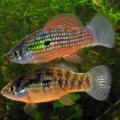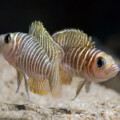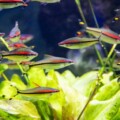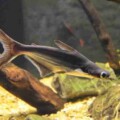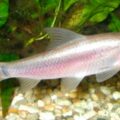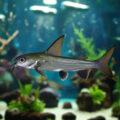All about the care, behavior, and tank needs of the Red-tailed Black Shark, a bold, fast-moving freshwater fish with a personality as fiery as its tail.
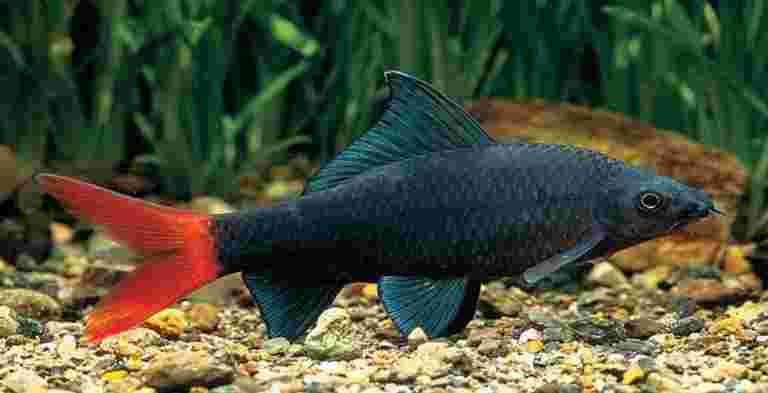
Introduction
Are you looking for a striking freshwater shark fish with a strong personality? Then get ready to meet the Red-tailed Black Shark (Epalzeorhynchos bicolor). It’s a sleek, jet-black fish with a blazing red tail that practically screams “centerpiece.”
Its dramatic coloring, semi-aggressive behavior, and unmistakable presence make it a favorite among aquarists who like their tanks bold. Good looks aside, the Red-tailed Black Shark is not your average community fish.
This species likes its space and isn’t shy about defending it. With this Red-tailed Black Shark profile, you’ll find out what makes this species so popular and how to handle its feisty, territorial side.
Before diving into keeping this shark fish, read this Epalzeorhynchos bicolor species overview that covers everything from its natural habitat and diet to tank setup and long-term care.
Author’s Note: Check out our post on the 14 Small & Big Freshwater Pet Sharks for more Freshwater Home Aquarium compatible shark lookalikes.
Native Habitat and Behavior in the Wild
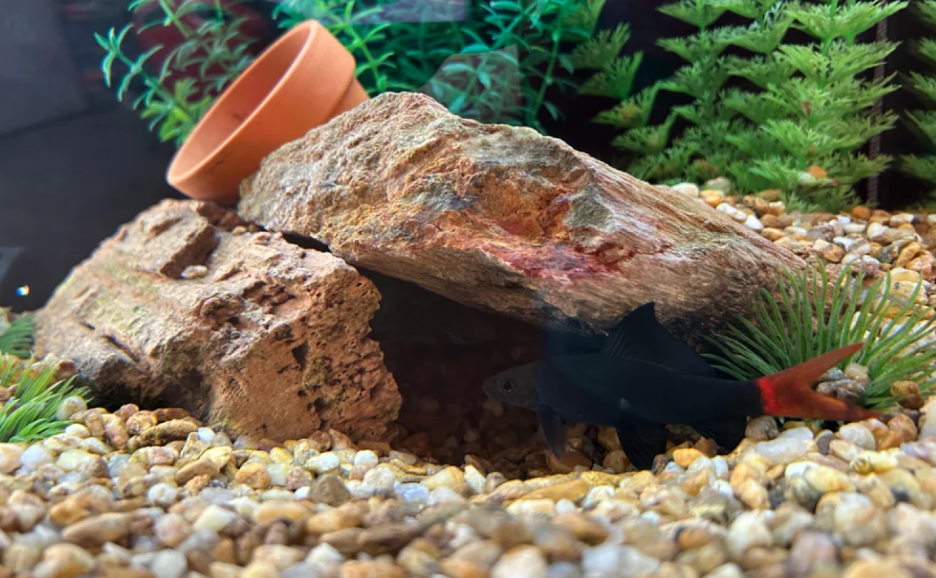
The Epalzeorhynchos bicolor’s natural environment is rooted in the freshwater rivers and streams of Thailand. In the wild, they’re solitary and highly territorial, often claiming their own hiding spots in the riverbank or cave and defending them from intruders.
Red-tailed Black Sharks are used to rocky creeks with lots of cover and gentle flow. This Thai river fish species are most active along the bottom and mid-level zones. You’d often find them darting through crevices, resting under driftwood, or patrolling their claimed territory with confidence.
This freshwater shark’s wild behavior carries over into home aquariums, so you’d want to plan your tank layout accordingly, and here’s how to do that.
Creating a Proper Tank Setup for Red-tailed Black Sharks
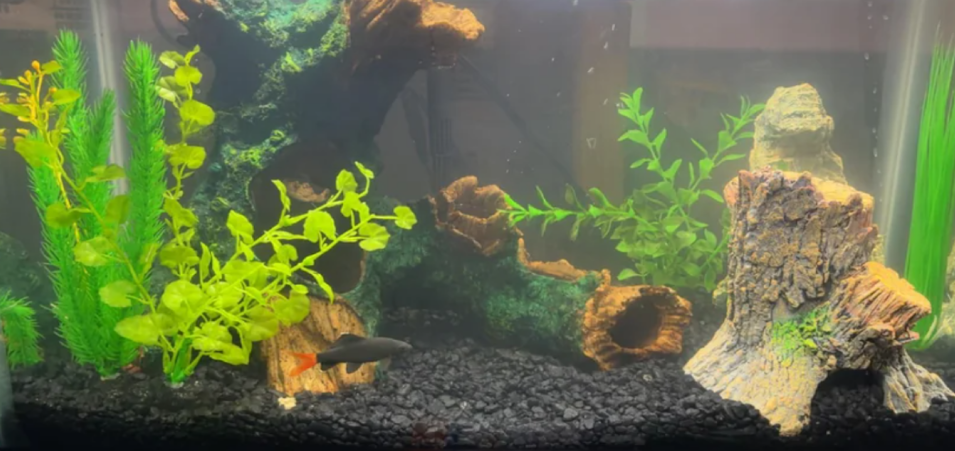
With the Red-tailed Black Shark, semi-aggressive fish tank planning is non-negotiable. The more natural and structured you can make your tank, the more confident and less combative your Red-tailed Black Shark will be.
It’s also important to stay on top of maintenance like clean filters, regular water changes, and stable conditions, to help reduce stress-related behaviors.
Tank Size
Creating the ideal Red-tailed Black Shark tank setup starts with lots of space. These fish are active swimmers and need room to roam and places to hide.
Anything under 55 gallons is too small for an adult, especially if you plan to add tank mates. A stressed shark in a cramped tank is a territorial nightmare waiting to happen.
Tank Features
Red-tailed Black Sharks like defined zones to retreat to, and without these, they may become overly aggressive or anxious. They thrive in environments with caves, tunnels, driftwood, and dense plant cover. This is super important to give them secure hiding spots, clear territory boundaries, and keep the tank peaceful.
Dim LED lighting setups can help a nervous fish feel more secure. Regular lighting works fine, but be sure to avoid harsh intensity.
A great Epalzeorhynchos bicolor aquarium design balances structure and open water. So make sure that there are long stretches of open water for your shark to cruise around.
Filtration and Flow
Use a moderate-flow filter to keep the water oxygenated and clean. To create an environment that can help the edge off their territorial instincts, this is a key step you don’t want to skip.
Author’s Note: Check out our post on the 7 QUIETEST Aquarium Filters for great home aquarium filtration systems.
Visual Characteristics and Growth Potential
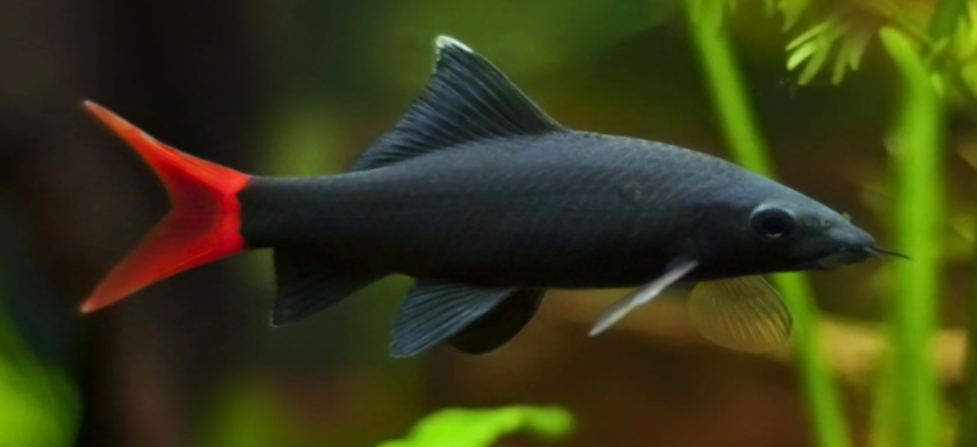
The Red-tailed Black Shark is an aquarium fish with a red tail that stands out without even trying. They mature and grow up to 6 inches long. You’d need to plan for that and design your tank appropriately.
Color Pattern
It’s easy to see why this species is so popular. The Red-tailed Black Shark has a dramatic color contrast: a deep black body paired with a bright fire-red tail that catches the light from across the room. Its freshwater fish contrast colors shine even more with a dark substrate, balanced lighting, and clean glass.
Unique Traits
If you’re new to identifying Red-tailed Shark features, here’s what to look for:
- A velvety jet-black body
- A bold red tail fin (no pattern or gradient, just pure color)
- A tall, upright dorsal fin that gives it that “shark” silhouette
- A slender, streamlined body shape that makes it a quick swimmer
- A posture that stiffens when they feel threatened
Diet and Feeding Preferences
Red-tailed Black Sharks are omnivores, and pretty chill when it comes to food. Epalzeorhynchos dietary needs are surprisingly flexible and must match their active lifestyle and mixed feeding habits. Here’s your go-to Red-tailed Shark feeding guide.
Feeding Schedule
To avoid overfeeding, feed your Red-tailed Black Shark once or twice daily in small portions, just enough that they finish everything in about 2 – 3 minutes.
Diet Suggestions
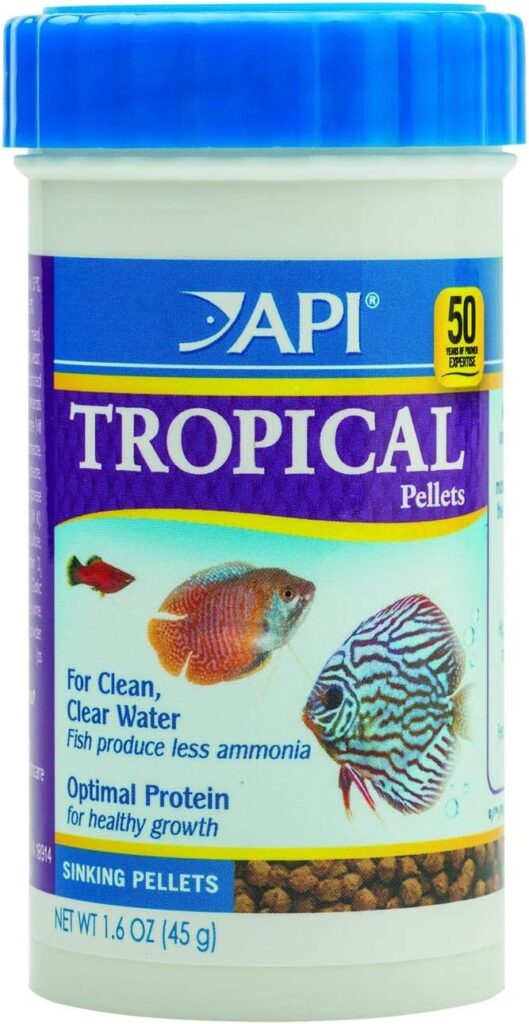
Found On Amazon
Keeping their meals varied is a big part of omnivore aquarium fish nutrition. Since they mostly feed along the bottom and mid-levels of the tank, avoid floating-only foods. Consider including sinking spirulina pellets, algae wafers, blanched veggies like zucchini slices, cucumber, or spinach, and protein treats like bloodworms, brine shrimp, or daphnia, a few times per week in their diet.
Here’s something you need to know about their dietary changes as Red-tailed Black Sharks age. Juveniles usually want more protein, while adults benefit from a plant-heavy base with occasional meaty extras.
Author’s Note: For more on feeding your aquatic pets check out The Ultimate Guide to Fish Food: Pros and Cons & Best Choices!
Choosing Compatible Tank Mates
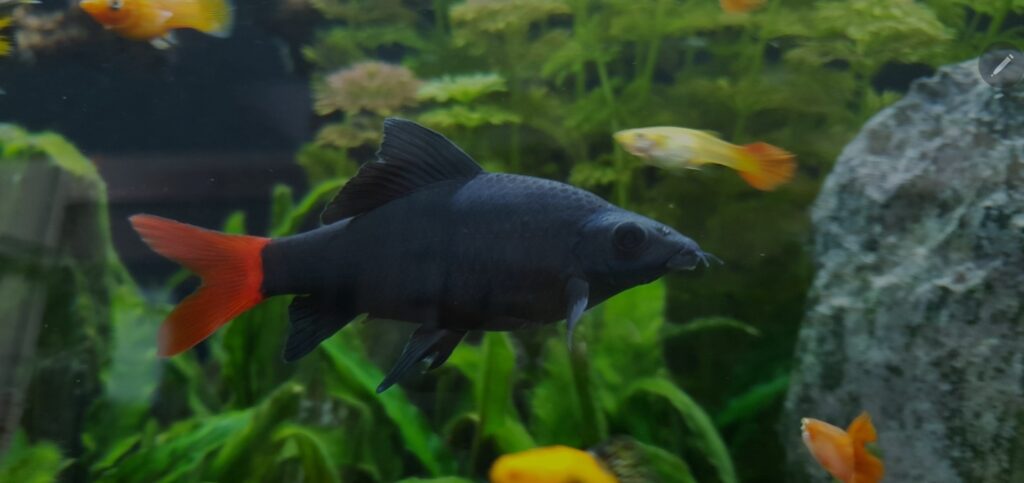
Choosing Red-tailed Shark tank mates can be tricky. These fish are semi-aggressive and will chase or harass anything they see as competition, especially other bottom dwellers, slow-moving fish, or similar-looking species.
Compatible Species
In smaller setups, solo keeping is often the safest route. But in larger tanks, a well-thought-out Epalzeorhynchos bicolor compatibility plan can work.
Their ideal companions should be fast, mid-to-upper-level swimmers, and non-aggressive. Good options include rainbowfish, larger barbs, and gouramis.
Tankmates To Avoid
Avoid housing your Red-tailed Black Shark in the same space as other sharks, especially Bala and Rainbow sharks. Don’t mix with loaches, dwarf cichlids, or bottom dwellers.
These semi-aggressive fish community tips can save you a lot of stress down the line.
Breeding Behavior and Captive Challenges
Epalzeorhynchos reproduction attempts at home often end in fighting or stress due to their territorial nature, and for most hobbyists, it isn’t worth the hassle. Here’s some general info for you if you’d like to know more about their breeding.
Captive Breeding
Breeding Red-tailed Black Shark in home tanks is extremely rare. In fact, almost all the ones you see in the hobby are bred commercially through hormone treatments, and this is something that is not possible for the average aquarist.
In a typical home tank, even getting a pair to tolerate each other without one claiming the tank and bullying the other can be difficult.
Spawning Method
If Red-tailed Black Sharks were to breed naturally, the process would follow that of most egg-laying freshwater fish. The female would scatter eggs, and neither parent would provide care.
Monitoring Health and Preventing Common Issues
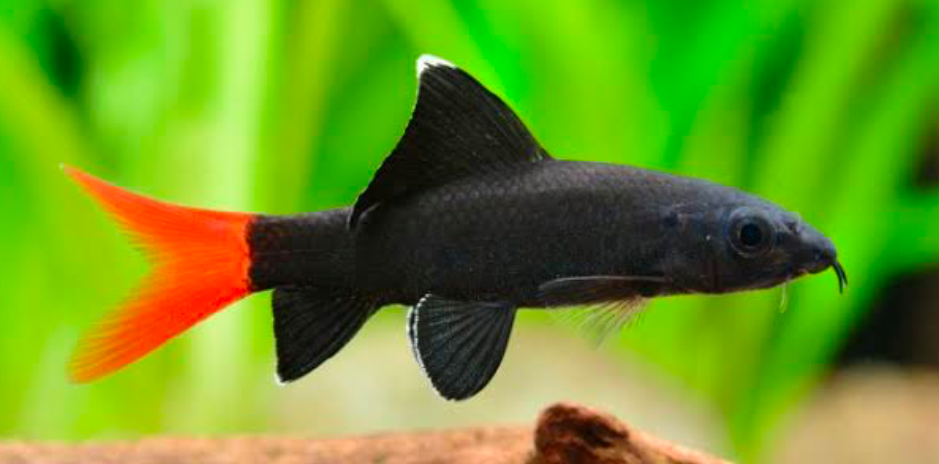
While tough, these sharks are still vulnerable to illness, especially if their environment isn’t right. Most issues stem from stress, poor tank layout, or bad water conditions. That’s why you need to have a well-designed tank to keep your fish calm, confident, and healthy.
Preventative Measures
A peaceful environment with consistent care is the best prevention strategy. Here are some top Red-tailed Shark health tips:
- Performing weekly water changes (25–30%)
- Avoiding overcrowding or inappropriate tank mates
- Testing for ammonia, nitrite, and pH regularly
- Watching behavior for sudden shifts—hiding, color fading, or inactivity
Common Issues
Stress in semi-aggressive fish can manifest physically and lead to common issues such as territorial injuries from chasing or fin nipping, fin rot, stress from incompatible tank mates, and bacterial or fungal infections
Spotting freshwater shark disease signs early is crucial. Watch out for clamped fins, loss of color, or sudden hiding.
Long-Term Care and Lifespan Planning
With proper care, Epalzeorhynchos bicolor lifespan can stretch to 6–10 years, making them a rewarding long-term aquatic pet. Long-term care means staying consistent with tank maintenance, feeding, and behavioral monitoring.
Size Expectations
They grow to about 6 inches and maintain that shark-like grace and confidence. Give them the room and respect they need, and they’ll be a highlight of your aquarium for years.
Care Needs
Essentials of long-term freshwater fish care should include:
- Adequate space (at least 55 gallons)
- Stable water conditions
- Balanced, varied diet
- Enriched environment with caves and visual breaks
- Careful monitoring of behavior and tank dynamics
When planning your semi-aggressive fish care plan, consider tank layout and future upgrades. These fish don’t stay small forever, and their personality often gets bolder as they mature.
Conclusion: A Bold Choice for Experienced Hobbyists
What do you get with a Red-tailed Black Shark? A vibrant personality, a bold look, and a territorial attitude that brings energy to your aquarium. So, if you’re looking for a freshwater shark for large tanks with loads of character, this is it!
In this Red-tailed Black Shark aquarium overview, one thing is clear. While it’s not the right fish for every setup, it becomes a stunning and engaging part of the tank for aquarists willing to provide the right space and care.
Just remember, it’s not the fish that adjusts, but the keeper. If you’re up for the challenge, this Epalzeorhynchos bicolor guide guarantees a successful experience.

